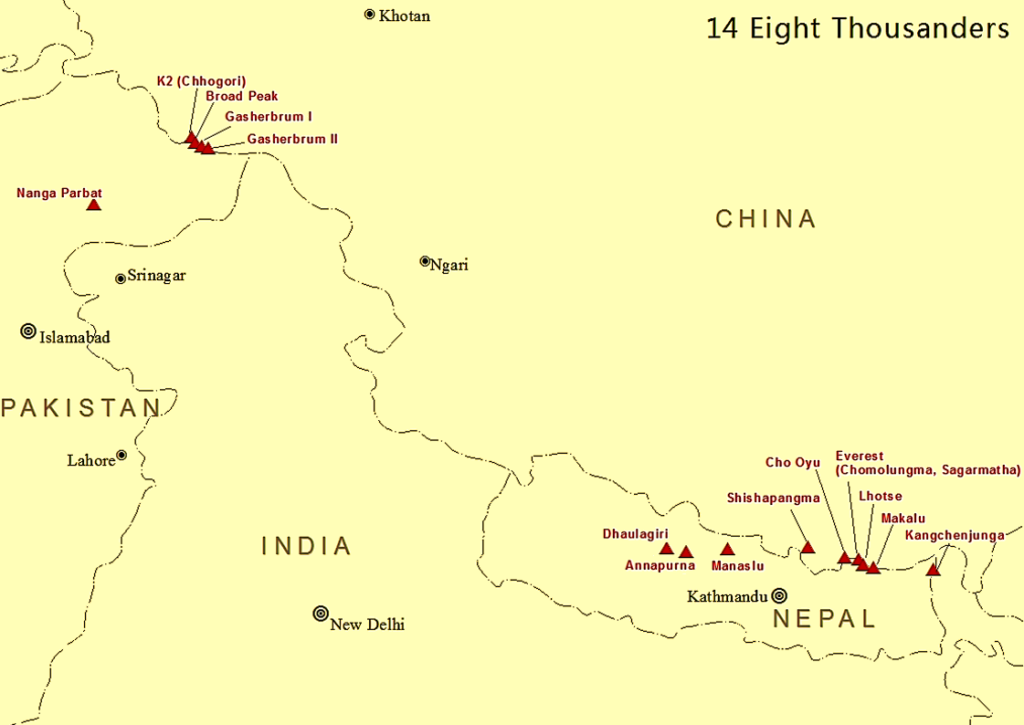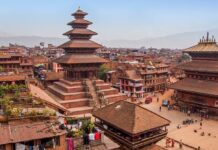Nepal is a country of Nature and is a gateway to the amazing Himalaya mountain range in the world. It is known as the land of the Himalayas in the whole world. There are 14 peaks above 8000 meters of which 8 peaks lie in Nepal. It emerged as a Beautiful destination for hikers &Trekkers of all types from all over the world. Nepal is rich in natural beauty, historic attractions and vast cultural heritage. This proves Nepal to be the perfect mix between the ancient and the modern, slow-paced lifestyles and majestic city life. In This post, we are talking about the mountain peaks above 8000 meters of Nepal.

Table of Contents
1. Mount Everest

Mount Everest is the world’s highest peak (8,848 meters). Lying in the Khumbu region of Nepal, the trail leading up to the Everest Base Camp is one of the most beautiful trekking trails on the planet. In Nepali Mt. Everest is known as Sagarmatha, in Tibetan Chomolungma, in Chinese Zhumulangma. Because of its massive trekking and hiking appeal, it attracts thousands and thousands of tourists every year. In 1865, Everest was given its official English name by the Royal Geographical Society, as recommended by Andrew Waugh, the British Surveyor General of India.
Also Read Sagarmatha National Park
2. Kanchenjunga

The Kangchenjunga is a mountain of the Himalaya range, at the far East of Nepal in Taplejung District. It is one of the 14 mountains on Earth that are more than 8,000 meters (26,247 ft) high above sea level. With an elevation of 8,586 m, Kangchenjunga is the third highest, after Mount Everest (8,850 m) and K2 (8,611 m).
The Kangchenjunga contains five peaks, four of them are above 8,400 meters: main summit (8,586 m), West summit (8,505 m), central summit (8,482 m), South summit (8,494 M) and Kangbachen (7,903 m).
Until 1852, Kangchenjunga was assumed to be the highest mountain in the world, but calculations based on various readings and measurements made by the Great Trigonometrical Survey of India in 1849 came to the conclusion that Mount Everest, known as Peak XV at the time, was the highest. Allowing for further verification of all calculations, it was officially announced in 1856 that Kangchenjunga is the third highest mountain in the world.
3. Lhotse

Lhotse is the fourth highest mountain in the world at 8,516 meters (27,940 ft), after Mount Everest, K2, and Kangchenjunga. Part of the Everest massif, Lhotse is connected to the latter peak via the South Col. Lhotse means “South Peak” in Tibetan. It lies in the Khumbu region of Nepal. In addition to the main summit at 8,516 meters (27,940 ft) above sea level, the mountain comprises the smaller peaks Lhotse Middle (East) at 8,414 m (27,605 ft), and Lhotse Shar at 8,383 m (27,503 ft).
4. Makalu
Makalu is the fifth highest mountain in the world at 8,485 meters (27,838 ft). It is located in the Mahalangur Himalayas 19 km (12 mi) southeast of Mount Everest. Makalu is an isolated peak whose shape is a four-sided pyramid.
5. Cho Oyu
Cho Oyu is the sixth-highest mountain in the world at 8,188 meters (26,864 ft) above sea level. Cho Oyu means “Turquoise Goddess” in Tibetan. The mountain is the westernmost major peak of the Khumbu sub-section of the Mahalangur Himalaya 20 km west of Mount Everest. The mountain stands on the China–Nepal border and the main summit is in Nepal.
6. Dhaulagiri I

Dhaulagiri I (8167m/26,795ft) is the seventh highest peak in the world and the fifth highest peak in Nepal. The name Dhaulagiri comes from the Sanskrit word where Dhawala means “Dazzling, White Beautiful” and Giri means “Mountain”. The normal climbing route for Dhaulagiri is the Northeast ridge. The exact coordinates are 28°41’48”N, Latitude and 83°29’42”E Longitude. Dhaulagiri was first summited by an Austrian, Swiss and Nepali expedition on May 13, 1960. Dhaulagiri I is the highest point of the Gandaki River basin. Dhaulagiri I and Annapurna I are when viewed from the South are just in front of each other and you can see both massive peaks from each summit.
Mount Manaslu is the eighth highest mountain in the world, located in the Masiri Himal range. It is the highest mountain in the Lamjung district, reaching an altitude of 8,156 meters. The mountain’s long ridges and valley glaciers offer a winsome sight of the surrounding celestial terrain. The word Manaslu is a derivative form of the word “Manasa” which means “the Mountain of Spirits”. The Nepalese government only permitted trekking to Manaslu in 1991. The trail follows an ancient salt-trading route that goes along the Burhi Gandak River.
7. Manaslu
Manaslu is the eighth highest mountain in the world at 8,163 meters (26,781 ft) above sea level. It is located in the Mansiri Himal, part of the Nepalese Himalayas, in the west-central part of Nepal. Its name, which means “mountain of the spirit”, comes from the Sanskrit word Manasa, meaning “intellect” or “soul”.
8. Annapurna
Annapurna is a massif in the Himalayas in north-central Nepal that includes one peak over 8,000 meters (26,000 ft), thirteen peaks over 7,000 meters (23,000 ft), and sixteen more over 6,000 meters (20,000 ft). The massif is 55 kilometers (34 mi) long and is bounded by the Kali Gandaki Gorge on the west, the Marshyangdi River on the north and east, and by Pokhara Valley on the south. At the western end, the massif encloses a high basin called the Annapurna Sanctuary. Annapurna I Main is the tenth highest mountain in the world at 8,091 meters (26,545 ft) above sea level, and in 1950 Maurice Herzog led a French expedition to its summit, making it the first of the eight-thousanders to be climbed.




